Accepted Scientific Name: Pritchardia hillebrandii Becc.
Malesia 3: 292 (1890)

Eupritchardia hillebrandtii (Pritchardia hillebrandii) Photo by: Forest Starr & Kim Starr
Habit at Hanamu Rd Makawao, Maui, Hawaii (USA). June 03, 2009.
Origin and Habitat: Pritchardia hillebrandiiSN|24628]]SN|24628]] is endemic of Molokaʻi, Hawaii islands, USA.
Habitat: It grows in dry forest near sea level, only about 300 Pritchardia hillebrandiiSN|24628]]SN|24628]] are said to survive a top to Huelo an Islet rising from the ocean just off the windward coast of Molokaʻi, and a few other trees exist on nearby Mōkapu Islet this is let due to the absence of rats and goats. Up to 1970's a few palm were reported in the valleys at the base of the sea cliffs of north coast of Molokaʻi, but today they are extinct.
Synonyms:
See all synonyms of Pritchardia hillebrandii
Common Names include:
ENGLISH: Molokai Fan Palm, Loulu Lelo Palm, Blue Loulu, Hillebrand's pritchardia, Hawaiian Fan Palm
HAWAIIAN (ʻŌlelo Hawaiʻi): Wāhane, Noulu, Loulu, Hāwane, Loulu lelo
Description: Pritchardia hillebrandiiSN|24636]]SN|24628]] is a small to medium sized palm with large fan-shaped leaves.
Stem: Solitary, upright, about 5-7(-8) m tall and 25 cm in diameter, smooth or fibrous when young, with vertical fissures on a dark grey background, and obscurely ringed by leaf scars. .
Leaves: 120-200 cm across, costapalmate, induplicate, undulate, forming half to two-thirds of a circle, only slightly divided; Segments (leaflets), single-fold, rigid, leathery, bifid with stiff points, that don't droop much, if at all, light emerald green, silverish or bluish-green and smooth above; waxy greyish green cast (glaucous) below and devoid of scales; Petiole and lower ribs unarmed, densely covered in ash-grey felt. The leaf sheath breaks down into a mass of tawny fibres.
Flower: Inconspicuous, not showy, pale white to yellowish flowers. The inflorescence is shorter or equal to the petioles with panicles branched to three orders. The flowers are perfect, containing both male and female parts.
Fruit: Small globose, and characteristically ridged, measuring around 22 x 19 mm on fruit stalks as long as the leaf stalks (petioles) of about 90-100 cm in length.
Seeds: 11-13 mm in diameter.
Remarks: Pritchardia hillebrandiiSN|24647]]SN|24628]] is related to Pritchardia glabrataSN|24634]]SN|24625]], Pritchardia kaalaeSN|28613]]SN|28613]], Pritchardia maidenianaSN|24625]]SN|24634]], and Pritchardia remotaSN|24628]]SN|24647]]. It is also similar to Pritchardia affinisSN|24628]]SN|24636]] but the heavy waxy coating on leaves and the black, ridged fruit are distinctive. There is one a smaller form of this palm with blue colouration called Dwarf Blue in this variety, the waxy glaucous coating extends to the leaf upper surface.
Bibliography: Major references and further lectures
1) Forest & Kim Starr Pritchardia hillebrandii (Loulu lelo). Plants of Hawaii. <http://www.starrenvironmental.com>. Downloaded on 21 August 2014.
2) Wikipedia contributors. "Pritchardia hillebrandii." Wikipedia, The Free Encyclopedia. Wikipedia, The Free Encyclopedia, 17 Mar. 2013. Web. 3 Sep. 2014.
3) Palmpedia contributors. "Pritchardia forbesiana." Palmpedia, PALM ENCYCLOPEDIA, <http://www.palmpedia.net> Downloaded on 26 Aug. 2014
4) Donald R. Hodel "Loulu-The Hawaiian Pritchardia" in the: The Palm Journal 193, page 12.
5) Native Plants Hawaii. “Pritchardia hillebrandii” web 21 August 2014. <http://nativeplants.hawaii.edu>
6) David Leaser "Growing Palm Trees in Hawaiʻi and Other Tropical Climates"
Don Ellison, Anthony Ellison “Cultivated Palms Of The World” UNSW Press, 01/May/2001
7) Gemmill, C. 1998. Pritchardia hillebrandii. The IUCN Red List of Threatened Species. Version 2014.2. <www.iucnredlist.org>. Downloaded on 03 September 2014.
8) Robert Lee Riffle & Paul Crafts "An Encyclopedia of Cultivated Palms", page 420.
9) Hawaiian Dictionaries http://www.wehewehe.org/
10) Donald R. Hodel "A Review of the Genus Pritchardia", pages S-3, S-8, S-19- 11) Audrey Sutherland "Paddling My Own Canoe", page 131.
12) PACSOA http://www.pacsoa.org.au/palms/Pritchardia/hillebrandii.html
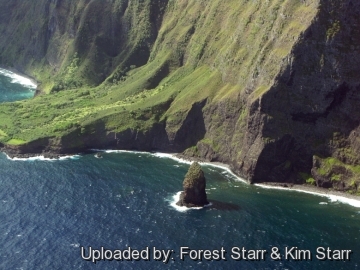 Habitat aerial at Huelo Islet and Papaiki Flats North Shore, Molokai, Hawaii (USA). July 02, 2012. (Pritchardia hillebrandii) Photo by: Forest Starr & Kim Starr
Habitat aerial at Huelo Islet and Papaiki Flats North Shore, Molokai, Hawaii (USA). July 02, 2012. (Pritchardia hillebrandii) Photo by: Forest Starr & Kim Starr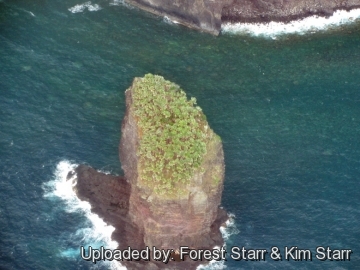 Habitat aerial at Huelo Islet North Shore, Molokai, Hawaii (USA). July 02, 2012. (Pritchardia hillebrandii) Photo by: Forest Starr & Kim Starr
Habitat aerial at Huelo Islet North Shore, Molokai, Hawaii (USA). July 02, 2012. (Pritchardia hillebrandii) Photo by: Forest Starr & Kim Starr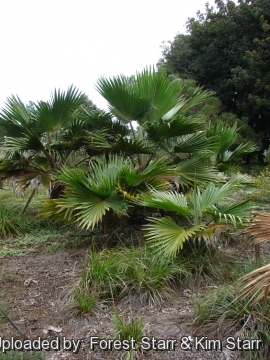 Habit in landscaping at Hanamu Rd Makawao, Maui, Hawaii (USA). June 03, 2009. (Pritchardia hillebrandii) Photo by: Forest Starr & Kim Starr
Habit in landscaping at Hanamu Rd Makawao, Maui, Hawaii (USA). June 03, 2009. (Pritchardia hillebrandii) Photo by: Forest Starr & Kim Starr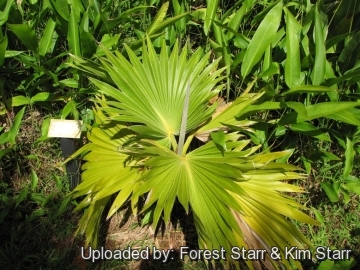 Habit at Garden of Eden Keanae, Maui, Hawaii (USA). March 30, 2011. (Pritchardia hillebrandii) Photo by: Forest Starr & Kim Starr
Habit at Garden of Eden Keanae, Maui, Hawaii (USA). March 30, 2011. (Pritchardia hillebrandii) Photo by: Forest Starr & Kim Starr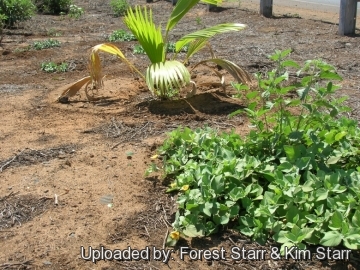 Habit at Kanaha Beach, Maui, Hawaii (USA). June 18, 2005. (Pritchardia hillebrandii) Photo by: Forest Starr & Kim Starr
Habit at Kanaha Beach, Maui, Hawaii (USA). June 18, 2005. (Pritchardia hillebrandii) Photo by: Forest Starr & Kim Starr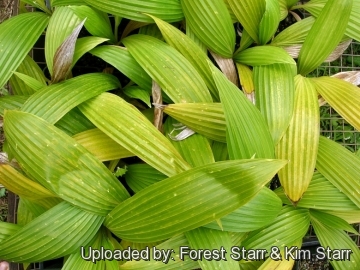 In pots at Makawao, Maui, Hawaii (USA). February 21, 2006. (Pritchardia hillebrandii) Photo by: Forest Starr & Kim Starr
In pots at Makawao, Maui, Hawaii (USA). February 21, 2006. (Pritchardia hillebrandii) Photo by: Forest Starr & Kim StarrCultivation and Propagation: Many Pritchardias are fussy and difficult to grow outside the tropics, frequently suffering from a yellowing of the leaves, but Pritchardia hillebrandiiSN|24628]]SN|24628]] is a pretty robust grower, very modest in its requirement, that likes sand, cinder or coral soil, but is adaptable to clay and loam both slightly alkaline and acidic. Good drainage is also important. It vary in shape. Specimens raised in dry and/or infertile soils tend to be smaller in stature with smaller leaves. Light also affects the plant's form while those grown in full sun are more compact.
Fertilization: Need a perfect fertilizer diet including all micro nutrients and trace elements or slow release fertilizer. Micronutrient deficiencies are occasional problems. Fertilize often for faster growth. Potted or younger loulu planted in the ground appreciate a foliar feeding monthly or bi-monthly.
Water Requirements: It tolerates low levels of humidity, though it prefers evenly moist but not consistently wet medium. When supplied with adequate moisture and fertilizer it is also fairly fast growing. This palm is very drought tolerant once established. It dislikes soggy soils. The roots and lower trunk can rot if soil is kept too moist. Water young plants for healthy look and fastest growth.
Light: Prefers full sun but will tolerate half day sun.
Hardiness: It is adapted to tropical and subtropical climates but tolerate a wide range of climates and will even tolerate cool conditions and a little frost ; they should be grown in cold green houses or at least in a place where they are sheltered by the wind; However mature specimens can endure temperatures down to about -4°C (for short periods), while young plants are more cold sensitive. Best kept above 5° C.
Maintenance: The dead leaves, flowers and fruits can be removed in a landscape setting for a cleaner appearance. Do not prune the fronds that still have some green colour. Palms recycle nutrients from dead or dying fronds and use them for healthier fronds. Palms only have a set number of new leaves that can sprout and grow per year and removing fronds will not increase that number. If you cut off more than what will grow annually, you could be left with a pretty bare and bald palm.
Wind and salt tolerance: Due to the natural coastal habitat, it does very well in low elevation landscapes and tolerates some salt spray. With a particularly windy climate it is suggested to secure young palm to long solid stakes, to avoid that the wind could bare young and not very developed roots; specimens which are only a few years old might fear intense wind.
Pest & diseases: It is prone to leaf rollers, red spider mites and sugar cane borers. Rats will eat the fruit.
Early Hawaiian Use The hard wood of the trunk were fashioned into spears. The trunks loulu were notched for climbing to gather the immature fruits and fronds. Older specimens still bear notches that can be seen today. The fronds were used for thatching and as plaiting such as papale (hats) and fans.
Food use: The young fruits called hāwane or wāhane are edible and can be eaten after being peeled. The flavour of fruit with the soft interior is similar to coconut.
Ornamental: It is cultivated as an ornamental tree, and planted in gardens and parks in tropical and sub-tropical climates either as a single specimen in small groves of three or more palms. Culture in containers is possible although growth rates are slower. A bright patio will provide an excellent environment for young specimens which can eventually be planted in a sunny location.
Propagation: Mature seeds buried half way in pot of clean, well drained potting soil, water daily, germinates within 4 weeks and grows quickly, plants of 30 cm can be put in ground/larger pot; Because these palms easily hybridize with other Pritchardias, claiming a specific species requires seed collection from wild populations.















